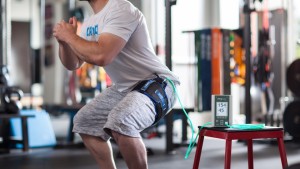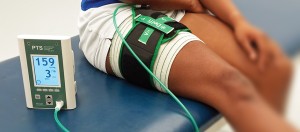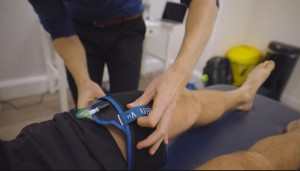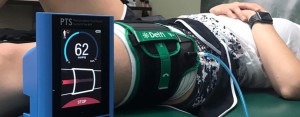Blood flow restriction training is becoming popular
Blood flow restriction (BFR) training allows you to work with lighter loads and obtain the same results as traditional strength training. Despite its promising future, it is not indicated for some people and it is still too early to give concrete guidelines on its use.

Blood flow restriction or BFR, the training that everyone's talking about
This type of training has gained a place in many conversations thanks to the popularity it has achieved in recent times.
Since it is possible to work with lower loads without affecting the results obtained, the BFR opens a range of possibilities to all those who need to gain muscle but cannot lift the loads usually required to achieve it, also relieving the joints and tendons.
RECOMENDADO

When do helmets have to be changed? Do they have an expiration date?

The best apps for cycling and mountain biking

Black Friday 2025 cycling bargains: save on Garmin, POC, Maxxis and more

Black Friday Garmin 2025: the ultimate guide to choosing your GPS at the best price

Which profile wheels to choose according to the area where you live: mountain, flat or coast

How to wash your cycling clothes? 10 keys to make them always look new
In other words, it could be a technique indicated for some groups such as people in the process of recovery or elderly people.
However, the still scarce scientific research on this technique - especially on its long-term effects - and the risks it entails in certain individuals require the evaluation of a professional to determine whether BFR can be applied in each specific case.

What is blood flow restriction training?
We can define training with blood flow restriction as a method by which, thanks to cuffs or tourniquets that restrict venous return, it is possible to work on strength with lower loads than usual, specifically, between 20% and 40% of 1RM.
It is important to note that while venous return is completely restricted, arterial flow is maintained (restricted by 50%-80%). For this reason, appropriate cuffs or tourniquets should be used and never substitute them with elastic bands or other homemade devices, which would also restrict arterial flow.
The BFR makes the body believe that it is working with a heavy load, which will trigger the reactions it sets in motion during a workout focused on gaining muscle mass: oxygen to the muscle tissues is lowered and muscle hypertrophy is stimulated.
Since the results will be similar to training without cuffs and tourniquets but with significantly heavier loads, the BFR will be an option for those who meet two requirements: not being able to lift the load needed to gain muscle in traditional training and being off the list of people who are at risk. This last point will be explored later.
The rest that we normally have to deal with in the early stages of recovery from an injury leads to atrophy. With the restriction of blood flow, you could start training earlier, so rehabilitation will be faster.
Therefore, this technique can be useful for athletes, who often need to be ready as soon as possible to meet their competitive schedule. Something that can also be applied to all of us who have not signed a professional contract but want to get back in shape as soon as possible.
An idea that can be interesting for older people, provided they do not have any contraindication to the contrary. In this way, it will be easier to combat the loss of muscle mass typical of age. The risk of blood clots makes it necessary in these cases to visit a doctor to decide whether it is advisable or not.
Because of the few studies on the long-term consequences of BFR, it is appropriate to apply this technique for a few weeks about 2-3 times per week.

What is needed and how to do it
As mentioned above, the sleeves or tourniquets are essential and cannot be replaced. They are available in different types and sizes on the market, although pneumatic sleeves must be chosen.
When placing it, it should be placed as close as possible to the limb to be trained. That is to say, if we work the arms we will place it between the shoulder and the biceps (without placing it directly on top), while if we exercise the legs we will place it near the groin.
Once it is in place, the pressure must be regulated. As we have said, it should be high to restrict venous return but low to maintain arterial flow. Since cuff sizes vary and each case is different, it is not possible to establish a size suitable for everyone.
To give a general idea, it could be between 100 and 200 mm Hg. Although there are also those who indicate that a pressure of 40%-80% can be used; and others who point more specifically to a restriction of between 30%-50% for the arms and between 50%-80% for the legs.
In any case, always read the manufacturer's instructions and consult a professional. It is advisable to start with lower pressures than would be appropriate to get used to the feel of the BFR.
As for the loads, the benefits are obtained with loads of 20% of 1RM. It is important to calculate this figure, since from 50% onwards, improvements are no longer noticeable.
Regarding the workouts, we recommend between 2 and 4 series of 75 repetitions, in blocks of 30-15-15-15-15. The rest time should be about 45 seconds per block and the movements should last two seconds in both the concentric and eccentric phases.
On the other hand, after each exercise, deflate the cuffs and wait one minute before continuing.
Total training time should be less than 10 to 15 minutes.

Is it dangerous?
This brings us to the hottest point of all, because there is no point in training that promises great results if it is dangerous. The truth is that the studies that have been carried out are mostly with healthy people, so it is still unknown how it can affect many different groups.
What is known is that people at risk of blood clotting (vascular diseases, obesity, diabetes, varicose veins, hypertension or having had a deep vein thrombosis) should not perform training with blood flow restriction.
In addition, pregnant women, people with heart disease or neurological pathologies, cancer and people with infections or wounds are not allowed to do it.
Furthermore, some symptoms such as dizziness, subcutaneous ecchymosis and numbness may occur. Other more serious side effects such as cerebral anemia, venous thrombi or pulmonary embolism have a very low incidence rate.
Thus, blood flow restriction training may be indicated for some population groups, although a specialist doctor should be consulted to ensure that its practice is appropriate and to await further research.